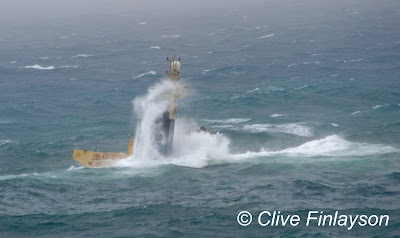This tranquil image of the Strait of Gibraltar, with the Rock in the foreground and Jbel Musa (Morocco) behind, gives little away in terms of how quickly the weather can turn at any time of the year. Africa and Europe are so close here that one might be forgiven for thinking they were connected. These two geological features were the Pillars of Herakles to the Greeks but it was probably the Phoenicians who first coined the phrase, with reference to their god Melkart.
But the Strait is a nightmare for sailors, and was particularly so for the ancient mariners of 2,500 years ago. Sea mists come in rapidly, with little warning. Here the Jbel Musa just peeps over the horizon and the Strait is lost in the fog.
But, worse still, are the huge waves that build up quickly when the winds blow from the east. The old folk used to tell me that there was always one big one at this time of the year - St. Joseph's Storm. It was so named because it came shortly before or shortly after St Joseph's day, the 19th March.
And they weren't far wrong. Most years there is a big easterly storm around this time. Some have had tragic consequences, as on the 17th March, 1891, when the SS Utopia sank in the Bay and 571 lives were lost. The tragedy is commemorated by this medal.
So imagine how the Phoenicians, in their little boats, must have felt about crossing the narrows! So they stopped in the northern pillar and prayed hard. They did so in Gorham's Cave (we have met this cave in connection with Neanderthals) and left offerings. This pottery mask is one such offering and I can't help feeling that I'm staring at a Phoenician mariner when I look at it.
Among their most prized offerings were scarabs. These were small, thumbnail sized, representations of scarab beetles in paste or glass. On the underside was usually a representation of an animal, person or a god. This one shows a lion jumping on an antelope. How did they get such detail into such a small item, especially as they did not have reading glasses?
Scarab beetles were revered by the Egyptians and, it seems also by the Phoenicians with whom they traded. Once common these great recyclers of the earth are becoming increasingly rare as we sterilise the countryside.
Inside the biological reserve in Doñana seems to be one of they few sanctuaries where sights like these, so common when I was a boy, are now harder and harder to find.
Perfect dung beetle country in Doñana, recalling a scarab scene (below)
Mare and foal represented in a Phoenician scarab from Gorham's Cave (above) and horseman (below)
This scarab (above) shows Horus, the god in falcon form, on the right. Below, a Peregrine rests on the cliffs above Gorham's Cave today
But returning to the St Joseph's Storm, if they come with rain they often cause falls of migrant birds coming from the south. These migrants often include Hoopoes (below):
Hoopoe on spring migration at Europa Point, Gibraltar, very close to Gorham's Cave
This Griffon Vulture never made it despite reaching the European shore. The weather got the better of him.
The big seas were a major worry for the Phoenicians. They were close to nature and used animals to help them navigate and keep close to good weather. Dolphins and Cory's Shearwaters were, like today in the Strait, welcome creatures.
Some things don't change. Here are some dramatic photos of wrecks caused by the treacherous storms in the Strait of Gibraltar, by Europa Point, in recent years:
No wonder the Phoenicians left offerings to placate the gods of the Pillars! And how lucky that the cave preserved them for us to excavate 2,500 years later.
Today's photos are from my archive. The mask and scarabs may be viewed in the Gibraltar Museum.























No comments:
Post a Comment